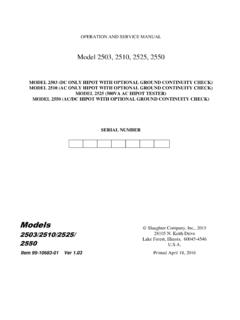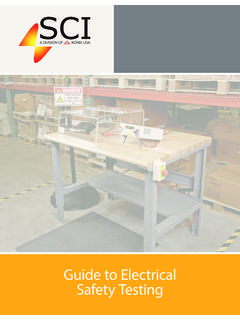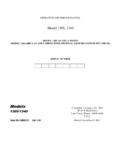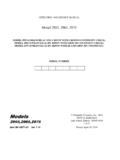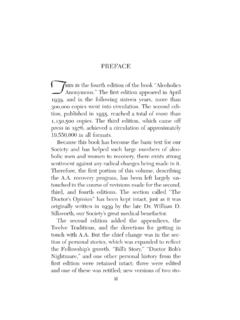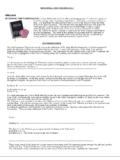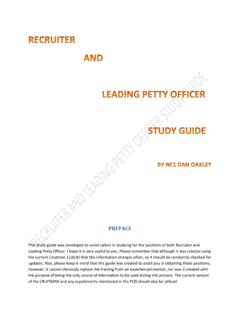Transcription of Preface - Slaughter Company
1 Electrical safety testing has historically been one of the most misunderstood,misapplied and misinterpreted inspection functions administered by manufac-turing companies. Some manufacturers have looked upon safety testing as anextraneous set of procedures that must be performed to satisfy some safetyagency standard. Although testing for product safety is a primary concern,electrical safety testing can yield valuable information about product designand integrity. To help manufacturers better understand the value of safety test-ing, the first edition of Basic Facts About High Voltage Testingwas written andpublished by Elmer Slaughter on January 18, 1957. Over the next 33 years continuously edited and updated the material with information rele-vant to performing high voltage tests. Slaughter Company is pleased to present this 10th edition to our valued cus-tomers.
2 The booklet has been updated to reflect current instrumentation andtechnology as well as offer general explanations of the most common high volt-age tests and how they are performed. We have also added sections pertain-ing to general safety precautions as well as useful testing tips and additional information, questions, or comments, feel free to contact us at1-800-504-0055 or online at Company , 2005 PrefaceSlaughter Company , N. Keith Drive, Lake Forest, IL 60045 USAToll Free: 1-800-504-0055 Phone: 1-847-932-3662 Fax: 1-847-932-3665 Email: : SAFETY ANDREASONS 11. Why Do I Need To Test?.. 12. Household Power and Electrical Safety 13. Product 24. What is Electrical Safety Compliance?.. 2 Examples of Common Safety Agency 3a. UL Standard 73 - Motor Operated 3b. #24 CRF (a).. 35. The European Union and the CE 36.
3 Common Electrical Safety 4a. Dielectric Voltage-Withstand 4b. Ground Continuity 4c. Ground Bond 4d. Insulation Resistance 41. Dielectric Voltage Withstand Test (Hipot).. 42. Leakage Current and Dielectric 53. General Hipot Test 54. AC vs. DC Hipot 65. Procedural 7a. Breakdown vs. 86. Ground Continuity 87. Ground Continuity Test 98. Ground Bond 99. Ground Bond Test 1010. The Ground Bond Test and the Hipot 1011. Insulation Resistance 1112. Insulation Resistance Test 121. Shock 122. Startle 123. Human Body 124. Test Operator Training 135. Test Station 136. General Test Procedure 14 CONTINUED Hipot Test 15a. Transformer 15b. Appliance 16c. Hot Hipot 16d. 500 VA Hipot 17e. Manufactured Home 182. Insulation Resistance Test 18a. Federal Aviation Administration and Aerospace Motor Microprocessor 192.
4 Line and Load 193. Electronic Ramp and 194. 195. PLC Remote 196. Tamper-Resistant Front 197. No Load 198. Front Panel Model 2205 Insulation Resistance 202. Model 1340 Modular/Manufactured Home Hipot 203. 2500 Series Basic Hipot 204. Model 1305 Hipot 205. Models 2512 and 2515 High Current Hipot 206. Model 2630 Enhanced Ground Bond 207. Model 2660 High Current Ground Bond 208. 2900 Series Enhanced Hipot 209. Model 4320 Multi-Function Electrical Safety 2010. 20 GLOSSARY 2005 Slaughter Company Inc. All rights reserved. No part of this book may be reproduced in any form or byany means without the express written consent of the publisher. Printed in the to differences in testing standards across the globe itis becoming increasingly important for manufacturers toensure that their products are safe for consumer andindustrial use.
5 What was once a general and loosely reg-ulated industry is now being flooded with stringent nation-al and international safety standards. The recent harmo-nization of safety standards in the European Union has ledto an increased concern by manufacturers to make surethat their products comply with EU , regulatory bodies like UL have led to stricterrules on electrical products sold domestically. Althoughmanufacturers of electrical products are becoming morefamiliar with electrical safety testing and compliance,many are still unfamiliar with this crucial part of the pro-duction NEED TOTEST?Safety agencies have implemented and enforced electricalsafety testing for one reason: to protect consumers frompotentially fatal electric shock. Many injuries and electro-cutions are caused by either electrical products with faultyinsulation or a product with a defeated safety insulation in question is used to separate the powerline circuit from everything else: low voltage circuits, iso-lated power supplies, the chassis or case of the product,etc.
6 This insulation prevents current from an ordinaryhousehold outlet, an almost unlimited power source, frombecoming hazardous by finding a ground /earth path withsomething that is not meant to be a ground ANDELECTRICALSAFETYTESTINGC urrent flows into any available ground/earthing pathbecause most power distribution systems are ground-referenced. When power is generated, one side of thegenerator output is connected to a ground at the point ofoutput. Every time power is transformed from one voltageto another, one side of the secondary is grounded. Inhousehold power distribution all neutral wires in a houseare connected to ground at a single point. Some power isdistributed ungrounded so that the system will tolerate onefault to ground without shutting down. This typically ishigh voltage intermediate ground distribution, not directlyaccessible to the end user.
7 Three-phase and 120/240 VACsystems also provide power across independentungrounded hot lines, but each of these lines is usuallyground-referenced independently and each provides a pre-dictable voltage to ground. Therefore, any line that contactsa ground path will allow current to flow. Figure 1 and 2each show a different example of how voltage is derivedfrom a 3-phase responsibility of performing electrical safety tests onconsumer products ultimately rests on the tests are performed to ensure that products includ-ing anything from household electric coffee makers tohairdryers and computers, meet industry standards forconstruction, performance, ratings, markings and instruc-tion from consumer safety, manufacturers have addi-tional reasons for safety testing.
8 Not only do manufactur-208240240120240N120/240V 3 4-Wire Delta System3-Phase Delta Transformer3-Phase Delta Transformerutility1203-Phase Y Transformer3-Phase Y Transformer208Y/120V 3 4-Wire Wye System208120120120208208 Nutility1 FIGURE1 FIGURE2ers want to prevent faulty components from beinginstalled in their products, but they also want to catchworkmanship defects in assemblies before they areinstalled. Following a proper safety testing procedure canhelp to identify production problems before a product isshipped, preventing costly recalls and embarrassing pub-lic announcements. Many manufacturers also performtests to ensure product quality for ISO compliance. Stillother manufacturers test to protect themselves from prod-uct liability suits. Whatever the reason may be, electricalsafety testing makes good sense for any consumer prod-uct products have been broken down into two spe-cific categories for electrical safety testing, Class I andClass II.
9 A Class I product is terminated in a 3-pronged linecord, specifically consisting of a hot and a neutral input,and an earth ground connection to chassis. Class II prod-ucts, also known as double insulated products, have noearth ground connection to chassis since the chassisitself is usually made of some insulating material such ISELECTRICALSAFETYCOMPLIANCE?Many manufacturers have heard terms such as UL listing,or CE mark, but aren't sure what they mean or how theyapply to their products. Both of these terms and more areused within the electrical safety compliance safety compliance is a general term used todescribe the testing procedures a manufacturer's productmust pass in order to be deemed safe to sell to con-sumers within specific countries. Many countries aroundthe world, including the , have their own test proce-dures to which electrical products must often than not, regulatory agencies establish thesecompliance test procedures.
10 They in turn provide their sealof approval, known as an agency listing, to a product thatmeets their standards (see figure 3). In the United States,one of the most popular agencies is Underwriter'sLaboratories (UL), in Germany, T V Rheinland, in China,China Compulsory Certification (CCC). It is important tonote that in the United States, as in many other countries,the Federal government isn't involved in regulating theseelectrical safety compliance agencies -- they are self-sus-taining and self regulating. As a corollary to this point, thereis no law in the that states a manufacturer musthave a listing in order to sell an electrical product. However,in order to compete in today's market and to avoid poten-tial customer injuries and lawsuits, obtaining a safetyagency listing is a addition to verifying the safety of their own productdesigns, it is also important for manufacturers to pur-chase safe equipment for use in their own productionprocesses.
